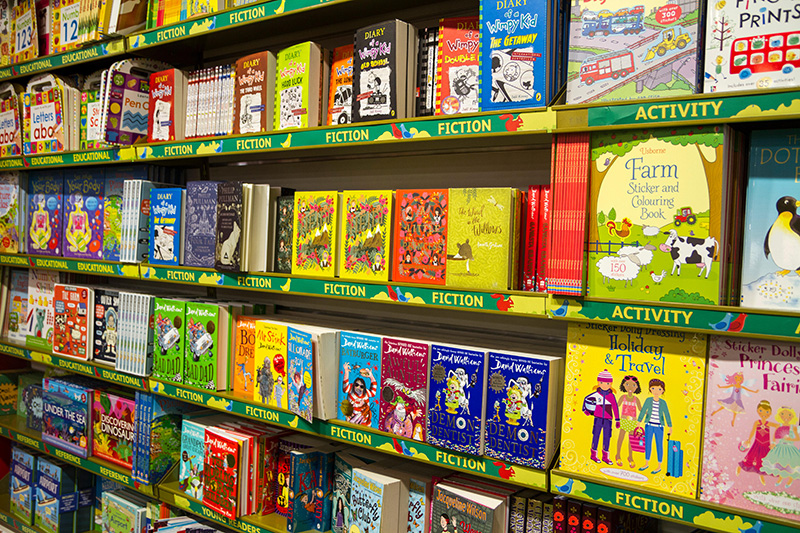A picture is worth a thousand words, we are told, and certainly it can have enormous impact. And the effect is much quicker than reading the thousand words; and a good picture stays with you. If this weren’t true, we would not have advertisements and illustrations. Picture books, from the quasi-factual to the fantastic, help us to build, shape and organise our mental world from when we are very small. You can tell a story in pictures alone, in words and pictures, or in words alone, but the popularity of pictures even in books for grownups (the Folio Society, cover art on paperbacks) is hard to deny.
Some of the impact that a book illustration can have is down to timing. When the children were little, we had a rule that if we were going to see a film based on a book, they had to have read the book first, before seeing the film. If you read a book first in pure text form, and have your own mental pictures of its events, you are more likely to object to some later illustrator’s conceptions, because yours will be more authoritative for you. We have more tolerance over different illustrations for stories like fairy tales, where we know that different people will draw them differently and we are exposed to different versions from an early age, but some people get very agitated when a beloved book is republished with new illustrations, or even just new cover art. I remember there was a kerfuffle when someone repackaged Jane Austen as if her books were chick lit, presumably to entice a different group of readers; I wonder how far some of them persevered with the books. Some must have enjoyed them, and every new reader is a good thing, surely.
I’m not keen on illustrations for adult books; just as I prefer radio to television because the pictures are better, I prefer my imaginings to other people’s. But I love children’s picture books, where the pictures are a balanced half of the narrative (choose your own favourites here). For these books, changing the illustrations seems unthinkable, except then it happens, and some people seem unaccountably to prefer the new version (Winnie the Pooh, for example, but I personally don’t wish to see any differently-illustrated version of (say) The Tiger that came to Tea, and the family refused flatly to go to the film version of The Little White Horse).
What about holy pictures? Through all the centuries when literacy was only for a favoured few, pictures were a powerful way to tell a story. Only, if it’s about some element of religion, it’s not regarded as a story, but the truth; and a major second problem is that many of the truths of religion are not easily shown in the form of pictures.
Many churches, even quite small ones, have a wall decorated with a portrayal of the Last Judgement (or “the Doom”) which must have had exactly the same function as the posters in a primary school. It was there as a visual aid for the priest to use to explain what was going to happen on the Last Day. Crib scenes and pictures help to show and explain the Nativity; crucifixion scenes show, in a devastating image, what happened to the baby when he grew up. Trying to picture God himself is an actual introduction to abstract art for some people. How would you do it?
Many sets of pictures are like a cartoon strip version of a local patron saint (often St Nicholas, St Barbara or Saint George, because of the wonderful opportunities for exciting pictures), and you can follow the whole story of the miracles or the various failed attempts at martyrdom before the soldiers get bored and end up just beheading the poor saint (Catherine of Alexandria, among others). And it’s worth learning about the distinctive elements that indicate which saint is which, from Peter with his keys to St Apollonia with her claws for extracting teeth, St Martin with his half cloak and sword and St Lucy with her eyes on a plate. The saints don’t need to wear name labels (though they sometimes have those as well), but they are clearly distinguished as if by badges.
But what about the power of pictures to mislead or misrepresent? Pictures are an interpretation, not a photograph; and nowadays we know that even photographs are not necessarily to be trusted. Part of the problem with holy pictures may be the feeling that holy art should be different, that historical accuracy or verisimilitude are not important, because the religious message of the picture is all that matters. This must be what lies behind all the blond Our Ladys and all the Jesuses in a long white nighty. But it’s very unhelpful if these are the only representations of the Lord that we see, especially when we are small.
Mediaeval holy pictures tend to be more realistic, with the artists painting scenes informed by real life as they knew it and the holy figures added in, sometimes (as in Breughel’s work) almost lost amid the crowds. But this is an area where the Victorians serve us badly, and unfortunately a lot of devotional art either dates from this period or is in this style. So there are a lot of pictures of Jesus with some of the apostles, but very few where he is in a group which includes the women who were undoubtedly there too (see Luke 8:1-3 and 23:55, Matthew 27:55 and so on). Old Testament pictures tend to have more women in them, because the stories are so good (Eve, Judith, Jael, Ruth and Naomi, Esther among others) and, of course, there are wonderful opportunities for pictures of the naked female body (Bathsheba, Pharaoh’s wife, Susanna), but these are less likely to be used in picture books for children. Stories from the New Testament, and specifically scenes from Jesus’ life, are where women are deliberately left out of the picture(s).
I have a collection of Missals, not just the old ones from my youth when the words changed often enough to make it worth being given one as a present after each new sacrament, but different modern ones from each of the jurisdictions that has its own anglophone Lectionary. The US and the Canadian missals have pictures (the Australians and the England-and-Wales ones have mostly abstracts), but there are incredibly few women in them unless it’s the Nativity or the non-canonical Stations of the Cross. Whether it’s a reproduction of a famous Last Supper or a pencil drawing to illustrate a parable in the Gospel, the pictures are only of men.
The Stations of the Cross are a fine example of my point. Named women are present in four or five of the usual line-up of the Stations (the number varies because of how the Crucifixion and the Deposition are pictured), but there are no other women present in the background figures. But it’s a main street, in a bustling city, full of people, just before a major festival; of course there would have been women in the crowds (going shopping if nothing else; somebody has to cook all those Passover meals).
Moreover, scenes portrayed in religious books, especially those for children, who are still creating their own understanding, tend to be spacious and peaceful, whether it’s the Sermon on the Mount or the lakeside at Galilee. But it can’t have been like that. If Peter and Andrew, and James and John were all making their living fishing in the lake, they were not alone. There would have been lots of people. They needed customers. If you think of any shore-side or lakeside fish market that you have seen, they are busy, bustling places, full of women sorting, gutting and selling the fish. They are full of noise and smells and energy.
Many hymns also distort our mental pictures of scenes from Jesus’ life. “In simple trust, like those who heard /Beside the Syrian sea /The gracious calling of the Lord” sounds peaceful and pastoral. But Jesus would have had to make himself heard across a market place like a Glasgow or London fish market, not a village common. There were lots of people; there were lots of women, even if the men involved in writing down these accounts several years later did not know more than a couple of their names.
There are of course occasional pictures of Jesus with a woman: the woman at the well, Peter’s mother-in-law, Jairus’ daughter and so on, but there are very few stories with a woman as one of the main characters (and even fewer where she is allowed a name), and this is obviously going to be reflected in the illustrations or the paintings. It is impossible to check, but I suspect that the incidence of women in holy pictures is even smaller than the balance of the stories would warrant.
And once you notice it, you keep noticing it. It’s not just in Missals, it’s in illustrated bible storybooks (of which I also have a fair few), and in other retellings, like the Ladybird books. If a woman has a name, it increases her chance of being in the pictures (so Priscilla and Lydia are pictured in the Ladybird life of St Paul), but there are remarkably few women overall. Of course there was a certain amount of social segregation at the time, but in any street there would be a few women probably in small groups, going about their legitimate business.
And this does matter. Pictures send messages, and one of the messages being sent here is that women don’t matter, aren’t included, don’t count. This is not a message we want to send to any of our children, let alone the female ones. Otherwise we normalise a narrative of exclusion which goes beyond pictures into our understanding of life and religion. If we consistently leave women out of the picture, we end up saying something like this: "In the light of the New Testament it is possible to discern how the primordial model of the family is to be sought in God Himself, in the Trinitarian mystery of His life...God in His deepest mystery is not a solitude, but a family, since He has in Himself Fatherhood, Son-ship and the essence of family, which is love." There is something (someone?) missing in this understanding of the family. Those words are from Pope St John Paul II (quoted in Scott Hahn’s First comes love). (Since I wrote this, I have discovered that the future Pope lost his own mother when he was very young.)
I do not think the Holy Spirit is the missing female, whatever the gender of the word is in Hebrew, Aramaic, Greek or Latin, any more than I think that God is male. From the Old Testament to Julian of Norwich and on into the moderns, God has been described in terms of motherly as well as fatherly love. But most of the families I know tend to have a mother or a mother-figure. Let us try to put women back into the picture. They belong there.



 Loading ...
Loading ...
What do you think?
You can post as a subscriber user ...
User comments (0)